#864 3-D View Of Jupiter's Clouds October 30, 1997
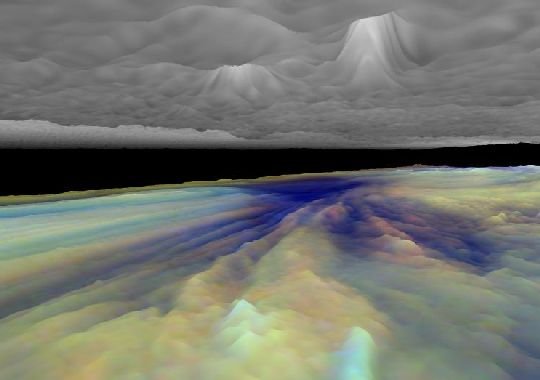
“very day is a cloudy day on Jupiter, the Solar System's reigning gas giant. This 3-dimensional visualization presents a simplified model view from between Jovian cloud decks based on imaging and spectral data recorded by the Galileo spacecraft. The separation between the cloud layers and the height variations have been exaggerated. The upper cloud layer is haze a few tens of miles thick. Heights in the lower cloud layers have been color coded; light bluish clouds are high and thin, reddish clouds are low, and white clouds are high and thick. Streaks in the lower layer suggestively lead to a dark blue area, a relatively clear, dry region similar to the site where Galileo's atmospheric probe made the first entry into a gas giant planet's atmosphere on December 7th, 1995."
Copyright: Public domain
#865 Haunting Mars October 31, 1997
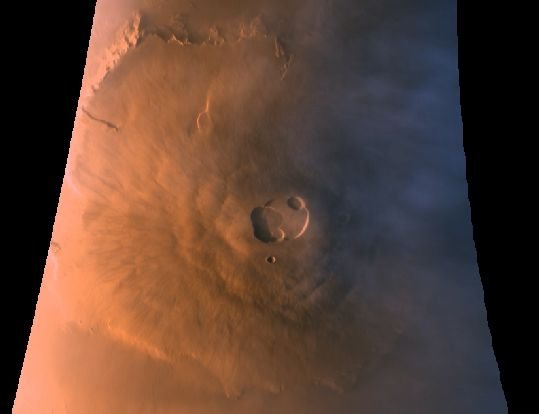
“This Halloween, the news about Mars is good news - Mars Global Surveyor will resume aerobraking into a mapping orbit around the haunting red planet. Wide angle cameras onboard the spacecraft recently recorded this shadowy image of Olympus Mons, the Solar System's largest volcano, from an altitude of over 100 miles. The summit depression or caldera of Olympus Mons is about 40 miles across and 15 miles above the Martian surface. On Halloween Night in 1938, Mars also made the news when Orson Welles' radio theatre adaptation of H.G. Wells' "War of the Worlds" - a fictional account of invaders from Mars - was dramatized as a live news report. The performance was so convincing it tricked some listeners, but most who heard the broadcast felt it was a treat. Have a happy and safe Halloween!"
Copyright: Public domain
#866 M31: The Andromeda Galaxy November 01, 1997
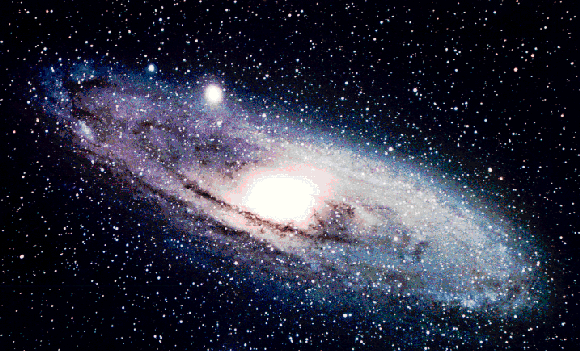
“Andromeda is the nearest major galaxy to our own Milky Way Galaxy. Our Galaxy is thought to look much like Andromeda. Together these two galaxies dominate the Local Group of galaxies. The diffuse light from Andromeda is caused by the hundreds of billions of stars that compose it. The several distinct stars that surround Andromeda's image are actually stars in our Galaxy that are well in front of the background object. Andromeda is frequently referred to as M31 since it is the 31st object on Messier's list of diffuse sky objects. M31 is so distant it takes about 2 million years for light to reach us from there. Much about M31 remains unknown, including why the center contains two nuclei."
Copyright: Jason Ware
#867 White Dwarf Stars Cool November 02, 1997
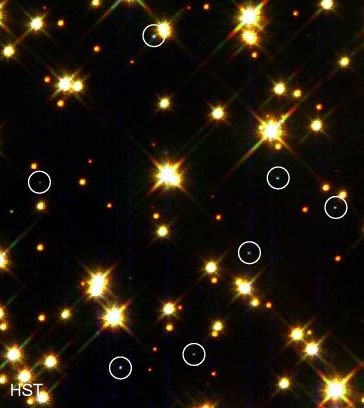
“Diminutive by stellar standards, white dwarf stars are also intensely hot ... but they are cooling. No longer do their interior nuclear fires burn, so they will continue to cool until they fade away. This Hubble Space Telescope image covers a small region near the center of a globular cluster known as M4. Here, researchers have discovered a large concentration of white dwarf stars (circled above). This was expected - low mass stars, including the Sun, are believed to evolve to the white dwarf stage. Studying how these stars cool could lead to a better understanding of their ages, of the age of their parent globular cluster, and even the age of our universe!"
Copyright: Public domain
#868 Irregular Moons Discovered Around Uranus November 03, 1997

“Where did these two irregular moons of Uranus originate? Last week two previously undiscovered moons of the distant gas planet were confirmed, the first in irregular orbits. All fifteen previously known moons of Uranus are 'regular', circling near the planet's equator. Most of these were discovered by the passing Voyager 2 spacecraft in 1986. These newly discovered moons are thought to be odd-shaped and about 100 km across. They are considered irregular, though, because they orbit in odd directions and far from Uranus. If Uranus' irregular moons have the same origin as those orbiting Jupiter, Saturn, and Neptune, then they were probably caught from orbits around the Sun. Moons like this are discovered by their motion. One of these moons is shown above as the circled point of light moving from left to right. (To stop the movie from repeating, click "stop" on most browsers.)"
Copyright: Public domain
#869 Blue Stragglers in Globular Clusters November 04, 1997

“This old dog is doing new tricks. On the left is ancient globular cluster 47 Tucanae which formed many billions of years ago. On the right is a closeup of its dense stellar center by the Hubble Space Telescope, released last week. Circled are mysterious stars called "blue stragglers." Stars as bright and blue as blue stragglers live short lives, much shorter than the age of the host globular cluster itself. But this contradicts evidence that globular cluster stars formed all at once. Although this problem has been known for almost 50 years, a mass and spin rate for a blue straggler was first published last Saturday. This new information indicates that BSS 19 was rejuvenated by two orbiting stars slowly coalescing , and not by a dramatic collision."
Copyright: Public domain
#870 The Milky Way's Gamma-Ray Halo November 05, 1997
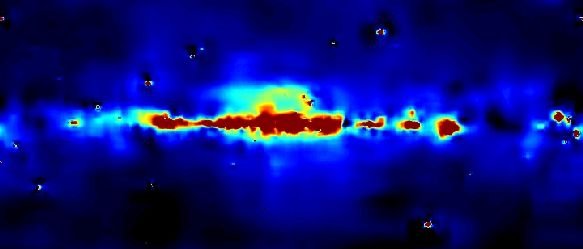
“Our Milky Way galaxy appears to be surrounded by a halo of gamma rays. Gamma rays are the most energetic form of electromagnetic radiation, with more than a hundred thousand times the energy of visible light, but known gamma-ray sources don't account for the diffuse distribution of this high-energy glow. This surprising result is based on data from the EGRET instrument onboard the Compton Gamma Ray Observatory. In this false color all-sky image centered on the Milky Way, the brown and green regions indicate brighter, known sources of gamma-rays. The galactic center and plane clearly standout as do some distant galaxies seen near the top and bottom of the picture. The dim, blue regions above and below the plane correspond to our Galaxy's unexpected gamma-ray halo. What causes the halo? Future gamma-ray telescopes could solve this mystery. However, the excitement has already inspired tantalizing speculation about the solution including; collisions of low energy photons with high-energy cosmic rays, high energy electrons accelerated by a previous burst of Milky Way star formation, and exotic interacting particles which make up Dark Matter."
Copyright: Public domain
#871 The Magnetic Carpet Of The Sun November 06, 1997
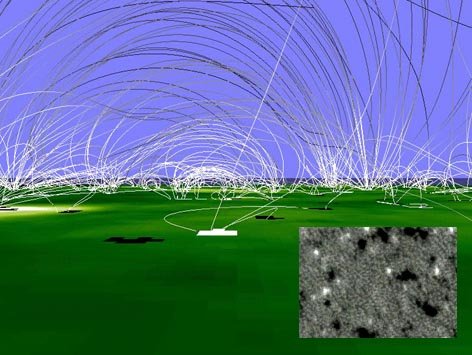
“The Sun has a magnetic carpet. Its visible surface appears to be carpeted with tens of thousands of magnetic north and south poles joined by looping field lines which extend outward into the Solar Corona. Recently, researchers have revealed maps of large numbers of these small magnetic concentrations produced using data and images from the space-based SOHO observatory. The above computer generated sunscape highlights these effects, with white and black field lines drawn in joining regions of strong magnetism. A close-up of the Solar surface is illustrated in the inset. These small magnetic regions emerge, fragment, drift, and disappear over periods of only 40 hours or so. Their origin is mystifying and their dynamic behavior is difficult to reconcile with present theories of rotationally driven large-scale Solar Magnetism. Is some unknown process at work? Possibly, but the source of this mystery may well be the solution to another -- the long standing mystery of why the outer Solar Corona is over 100 times hotter than the sun's visible surface! The SOHO data reveal that energy released as these loops break apart and interact seems to be heating the coronal plasma."
Copyright: Public domain
Upvote! Resteem! Comment! As you like it! Thank you for attention!
Curious?
introduction post
introduction post
Check out the great posts I already resteemed.Resteemed by @resteembot! Good Luck! The @resteembot's The @reblogger's Get more from @resteembot with the #resteembotsentme initiative
Resteemed to over 5900 followers and 100% upvoted. Thank you for using my service!
Send 0.100 Steem or 0.100 Steem Dollar and the URL in the memo to use the bot.
Read here how the bot from Berlin works.
@resteem.bot